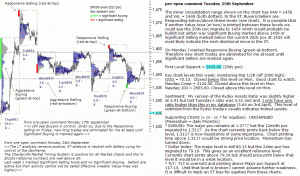posted 9.14 a.m. et
pre-open comment Tuesday 25th September
The minor consolidation range shown on the chart has VAH = 1458 and VAL = 1448 (both dotted). In the ST, Buyers/Sellers are Responding below/above these levels (see chart). It is possible that if another Value Area (or two) is printed between these levels we could see the 20dy poc migrate to 1454 which would probably be bullish but either way Significant Buying marked above 1458 or Significant Selling marked below the current 20dy poc at 1435 will most likely indicate the next directional move in the ST.
On Monday I marked Responsive Buying (green-at-bottom). Therefore new short trades are eliminated for me at least until Significant Sellers are marked again.
First Level Support = 1435.00 (20dy poc)
Key chart levels this week: monitoring Maj 1/2R (off 2000 high):
QQQ = 70.13. Closed below this level on Mon. Good chart to watch.
Nasdaq Comp = 3120.50. Closed above this level on Mon.
Nasdaq 100 = 2805.60. Closed above this level on Mon.
Sentiment: My version of the Rydex Assets Ratio was slightly higher at 4.91 but last Tuesday’s ratio was 5.51 and and I only have one ratio higher than this in my database (5.64 on 3rd April). This level of optimism from the Rydex traders usually indicates limited upside.
Supporting Charts (+ or – or ? for equities). UNCHANGED
(Momentum = daily PriceOsc)
? EURUSD: The major poc remains at 1.2777 but the 12mnth poc migrated to 1.3117. As the chart currently prints back below this level, 1.3117 is now Resistance of some importance. Chart printing time above 1.3117 would be strong price location. Momentum has turned down.
? Dollar Index: The major level is still 80.15 but the 24mn poc has migrated to 79.19. This gives us an excellent reference level. Currently chart prints above 79.19 but should price print below that level it would be in a weak location.
? TLT: TLT is oversold and printing above Major poc Support at 117.15. Until that level is broken I cannot assume further weakness.
It is difficult to imply an ST bias for equities from these charts.
